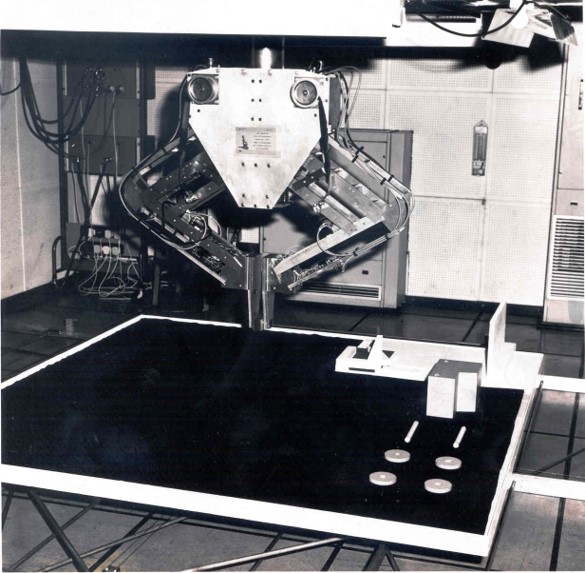Professor Chris Williams
Chair of Machine Learning, Director of Edinburgh Laboratory for Integrated AI
The start of Artificial Intelligence (AI) research at Edinburgh can be traced back to a small research group established at 4 Hope Park Square in 1963 under the leadership of Donald Michie. In 1965 this became the Experimental Programming Unit with Michie as Director. In 1966 the Department of Machine Intelligence and Perception (DMIP) was formed, funded by a large SRC grant held by Donald Michie, Christopher Longuet-Higgins and Richard Gregory. The latter two had left Cambridge to come to Edinburgh. Bernard Meltzer set up the Metamathematics Unit in the Faculty of Science in the mid 1960s, and was the founding editor of the Artificial Intelligence Journal in 1970. At this time Edinburgh was one of the few centres in the world working on AI.
During this period there were remarkable achievements in a number of sub-areas of the discipline. However, from the outset these scientific achievements were marred by significant intellectual disagreements about the nature and aims of research in AI and growing disharmony between the founding members of DMIP. Gregory resigned in 1970 to go to Bristol University, and Longuet-Higgins moved to Sussex University in 1974. In 1974 the Department of Artificial Intelligence was formed. Its first head was Meltzer, who stepped down in 1977 and was replaced by Jim Howe who led it until 1996. A separate unit, the Machine Intelligence Research Unit, was set up to accommodate Michie's work. In 1984 the Artificial Intelligence Applications Institute (AIAI) was formed to promote the application of AI research for the benefit of commercial, industrial, and government clients. Austin Tate was appointed Director of AIAI in 1985.

One of the seminal achievements of AI researchers in Edinburgh in the early years was Freddy the Robot (or FREDERICK: Friendly Robot for Education, Discussion and Entertainment, the Retrieval of Information and the Collation of Knowledge), which was capable of assembling objects automatically from a heap of parts. It is now on display in the National Museum on Chambers Street.
Also in 1963, the University created the Computer Unit, and Sidney Michaelson was appointed its Director. In 1966 the Unit was split into the Department of Computer Science (DCS), led by Michaelson, and the Edinburgh Regional Computing Centre. Sidney Michaelson was appointed the first Professor of Computer Science in 1967. DCS moved to the James Clerk Maxwell building at the King's Buildings site in 1971. One of the major projects in DCS was the Edinburgh Multi-Access System (EMAS), an early multi-user operating system. In the early 1980s an "Advanced Personal Machine" was developed for teaching, and 60 were installed by 1985. In 1987 the Laboratory for Foundations of Computer Science was formed by Rod Burstall, Robin Milner and Gordon Plotkin to foster research on theoretical computer science.
In 1969 Christopher Longuet-Higgins founded the School of Epistemics, an interdisciplinary group which brought together people with an interest in the mind. Longuet-Higgins defined epistemics as "the construction of formal models of the processes - perceptual, intellectual, and linguistic - by which knowledge and understanding are achieved and communicated". When Longuet-Higgins left in 1974, Barry Richards of the Department of Philosophy became the Director of the School. In 1985 the School of Epistemics became the Centre for Cognitive Science, a department within the Faculty of Science devoted exclusively to research and postgraduate teaching.
In 1989 the Human Communication Research Centre (HCRC) was formed, involving the Universities of Edinburgh, Glasgow and Durham, with funding from ESRC. Its first Director was Keith Stenning.
The Division of Informatics (later the School of Informatics) was created in 1998 from the Department of Artificial Intelligence, the Centre for Cognitive Science and the Department of Computer Science, along with the Artificial Intelligence Applications Institute and the Human Communication Research Centre. This process was led by Michael Fourman. Robin Milner's vision of a new science of information, broader than computer science, inspired the formation of the School.
In 1998 Informatics was spread over four sites---South Bridge, Forrest Hill, Buccleuch Place and the James Clerk Maxwell Building. The School was brought together under one roof with the opening of the Informatics Forum in 2008.
The School currently has six research institutes, namely the Artificial Intelligence and its Applications Institute (AIAI); the Institute for Adaptive & Neural Computation (ANC); the Institute for Computing Systems Architecture (ICSA); the Institute for Language, Cognition & Computation (ILCC); the Institute of Perception, Action & Behaviour (IPAB); and the Laboratory for Foundations of Computer Science (LFCS).
2023 marks the 60th anniversary of the start of work on Artificial Intelligence and Computer Science at the University of Edinburgh.
Acknowledgments
Thanks to Peter Buneman, Alan Bundy, Pat Hayes, Gordon Plotkin, George Ross, Don Sannella, Mark Steedman and David Willshaw for their input.
Further reading
Jim Howe: Artificial Intelligence at Edinburgh University: A Perspective. last revision 2007

